
Bengali cuisine is the culinary style of Bengal, that comprises Bangladesh and the Indian states of West Bengal and Tripura. The cuisine has been shaped by the region's diverse history and climate. It is known for its varied use of flavours including mustard oil, as well as the spread of its confectioneries and desserts. There is a strong emphasis on rice as a staple, with fish traditionally the most common protein. Freshwater fish are preferred to seafish, although barramundi, known as bhetki, is also common. Meat is also a common protein among Bengalis with chicken and mutton meat being the most popular. Beef is popular within the muslim community. In more recent times, lentils have begun to form a significant part of the diet. Many Bengali food traditions draw from social activities, such as adda, Poila Boishakh, Eid feast.

Kulfi is a frozen dairy dessert from the Indian subcontinent. It is often described as "traditional Indian ice cream". Kulfi originated in 16th-century Delhi during the Mughal era. It is part of the national cuisines of India, Pakistan, and Trinidad and Tobago. It is also popular in Bangladesh, Myanmar, Nepal, Sri Lanka, and the Middle East.
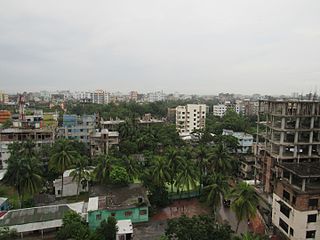
Comilla District, officially known as Cumilla District, is a district located in southeastern Bangladesh. It lies about 100 kilometres south east of Dhaka. Comilla is bordered by Brahmanbaria and Narayanganj districts to the north, Noakhali and Feni districts to the south, Tripura state of India to the east and Munshiganj and Chandpur districts to the west.

Gulab jamun is a sweet confectionary or dessert, originating in the Indian subcontinent and a type of mithai popular in India, Pakistan, Nepal, the Maldives and Bangladesh, as well as Myanmar. It is also common in nations with substantial populations of people with South Asian heritage, such as Mauritius, Fiji, Gulf states, the Malay Peninsula, Great Britain, South Africa, and the Caribbean countries of Jamaica, Trinidad and Tobago, Guyana, and Suriname.

Jalebi, is a popular sweet snack in the Indian subcontinent, West Asia and some parts of Africa. It goes by many names, including jilapi, zelepi, jilebi, jilipi, zulbia, jerry, mushabak, z’labia, or zalabia.

Rasgulla is a syrupy dessert popular in the eastern part of South Asia. It is made from ball-shaped dumplings of chhena dough, cooked in light sugar syrup. This is done until the syrup permeates the dumplings.

Bangladeshi cuisine has been shaped by the region's history and river-line geography. Bangladesh has a tropical monsoon climate. The staple of Bangladesh is rice and fish. The majority of Bangladeshi people are ethnic Bengali, accustomed to Bengali cuisine, with a minority of non-Bengalis, many used to cuisines from different traditions and regions. Bangladeshi cooking features more meat dishes than the cuisine of neighbouring West Bengal, India.
Mithai (sweets) are the confectionery and desserts of the Indian subcontinent. Thousands of dedicated shops in India, Bangladesh, Nepal, Pakistan and Sri Lanka sell nothing but sweets.
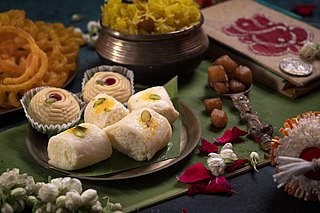
Sandesh is a dessert, originating from the Bengal region in the eastern part of the Indian subcontinent, created with milk and sugar. Some recipes of sandesh call for the use of chhena or paneer instead of milk itself. Some people in the region of Dhaka make a variety of sandesh called pranahara which is softer and made with mawa and yogurt. The Gupo/Gufo style of sandesh from Guptipara is considered by some to be the "first branded sweet of Bengal".

Pithas are a variety of food similar to pancakes, dumplings or fritters, originating from the Indian subcontinent, common in Bangladesh and India. Pitha can be sweet or savoury, and usually made from a dough or batter, which is then steamed, fried or griddled. Very few varieties are oven-baked or boiled, and most are unleavened and cooked on a stovetop. Some versions may have a filling, garnish, or sauce. Few may be set or shaped after cooking. They are typically eaten as a snack with chai, or as treats during special occasions.

The Bengali dialects or Bengali varieties are the varieties of the Bengali language that are part of the Eastern Indo-Aryan language group of the Indo-European language family widely spoken in the Bengal region of South Asia. The spoken dialects of Bengali are mutually intelligible with neighbouring dialects.

BBC Bangla is the Bengali language service of the BBC World Service, inaugurated in 1941 for Bengali audiences worldwide, especially the ones in the Bengal region, which includes the sovereign state of Bangladesh and the Indian states of West Bengal and Tripura.

Milk skin or lactoderm refers to a sticky film of protein that forms on top of dairy milk and foods containing dairy milk. Milk film can be produced both through conventional boiling and by microwaving the liquid, and as such can often be observed when heating milk for use in drinks such as drinking chocolate. It is caused by the denaturation of proteins such as beta-lactoglobulin. The thickness of the skin varies dependent on a number of factors, including the temperature of the milk, the shape of the container, and the amount of milk in the container.

Chhena or chhana is a kind of acid-set cheese originating from the Indian subcontinent that is made from water buffalo or cow milk by adding food acids such as lemon juice and calcium lactate instead of rennet and straining out the whey.

Krishna Chandra Das (1869–1934), commonly referred to as K.C. Das, was a Bengali confectioner, entrepreneur, businessman and Bengali cultural icon of the early 20th century. Born in 1869 in Bag bazar, Kolkata, Krishna Chandra was the only son and successor of the Bengali confectioner and sweetmeat inventor Nobin Chandra Das. Krishna Chandra was a versatile enthusiast with a spirit of scientific exploration. He developed an electric loom, a soda fountain machine, did extensive research on homeopathy, and researched eastern and western classical music. Krishna Chandra Das became an iconic figure in the 1930s Kolkata as one of the creators of "Rosso Malai" and invention of the vacuum canned "Rosso Golla", which were popularized and promoted throughout India by his family organization K.C. Das Private Limited, founded by Krishna Chandra's son and successor Sarada Charan Das.
Mirzapur is a village in Ishwarganj Upazila of Mymensingh District in the Division of Mymensingh, Bangladesh.
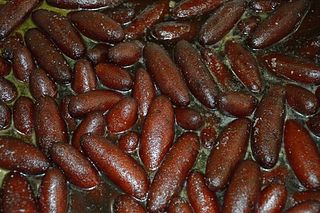
Lyangcha, Langcha, or Lemcha, is an Indian sweet dish prepared in West Bengal, Jharkhand, Odisha, Bihar, Assam, Tripura and also throughout Bangladesh. It is made from flour and milk powder by frying it and dipping it into sugar syrup for a long time. The origin of the sweet is in Bardhaman, West Bengal, India. The Government of West Bengal has begun the process of registering Geographical indication (GI) for Lyangcha.
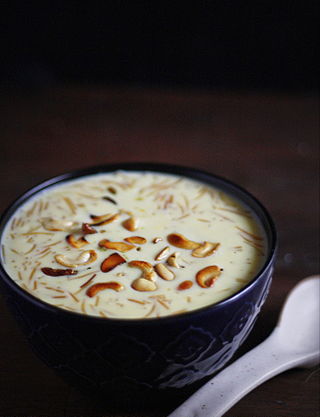
Shemai is a traditional dessert item in Bangladesh and West Bengal, India. Shemai is a popular item during Eid, but it is consumed throughout the year. Shemai is a dessert form of vermicelli, soaked in sweet milk and often garnished with nuts.
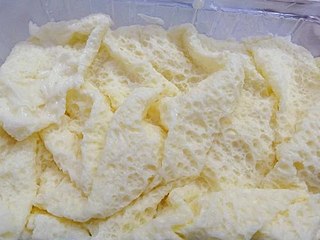
Qishta, also known as kishta, kashta , ghishta, or ashta, is a dairy coagulated milk product prepared from heated fresh milk and consumed as a dessert. It is sometimes scented with orange flower water.

Matri Bhandar is a Bangladeshi traditional confectionery store well known for Rasmalai. The taste of Rasmalai of Matri Bhandar has been appreciated in various national and international important places and events. Rasmalai of Matribhandar is on the list of favorite food of various famous and important personalities. Among them are Earl Robert Miller and Geeta Pasi who expressed their love for Matri Bhandar's product.






















